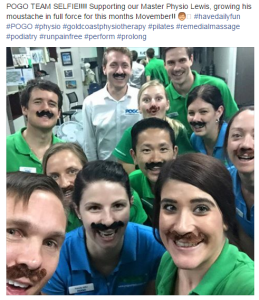Improving the face of men’s health
Improving the face of men’s health – Lewis Craig
Each November, the Movember Foundation takes over the face of men’s health, seeing an increasing number of moustaches grown to raise awareness and create positive change for men’s health. It’s not as simple as the growth of some facial hair, although this can be difficult for some, there’s a powerful message behind the ‘Mo’. Movember serves as a timely reminder of the poor climate of men’s health in Australia and internationally.
Improving the face of men's health Share on X
Male Life Expectancy in Australia
Men in Australia can expect to live on average 4 years less than females (AIHW, 2015). Men also die at a higher rate at all stages of life and generally have higher incidence of non-gender specific cancers. Men experience higher rate of cardiovascular diseases and at earlier ages. Men have a higher rate of death from injury and motor vehicle accidents are over-represented at Emergency Departments around the country. There are also unique gender specific challenges faced by men. Prostate cancer is the most common cancer in males in Australia and the 4th leading cause of death (AIHW, 2015). 1 in 7 men will be diagnosed with prostate cancer before the age of 75 and its incidence is predicted to double by 2017 (MF, 2015).
The Weigh In
It isn’t just older Australia males that experience these health challenges. For men over 25 years of age, 75% are overweight (44%) or obese (32%) (AIHW, 2013). An increase in body weight is linked to the development on many chronic diseases such as cardiovascular disease, some cancers, diabetes and numerous musculoskeletal conditions. Not only does it increase the risk of these conditions but it can hamper the ability to manage them. In young men aged 18 – 39 years testicular cancer is the second most common cancer, behind skin cancers, with the average age of diagnosis just 36. Amongst young males other important health issues are sexual health, alcohol and drug use, motor vehicle accidents and suicide. Sadly, 82% of suicides are males ending their life.
A Visit to The Doctor
It is a common assumption that many men don’t visit the doctor. Population surveys have shown that men do in fact visit their GP with 80% visiting in the previous year (Holden et al. 2005). The common issue then becomes that the consults are too short or only for one purpose such as to refill a script. There is need to assess men’s health comprehensively to then work collaboratively to towards meaningful changes.
Movember and its Men’s Health Endeavours
The Movember Foundation focuses upon four key areas of men’s health.
- Prostate Cancer
The prostate is a gland that sits below the bladder, in front of the bowels. Prostate cancer occurs when some of the cells in the prostate multiply more rapidly than normal, resulting in a tumour growth. If left untreated, prostate cancer cells may eventually spread from the prostate to the lymph nodes and bones, producing secondary tumours. Most prostate cancers develop without men experiencing any symptoms in the early stages and thus the importance of regular screening becomes vital. However, some men will experience changes in urinary or sexual function that might indicate the presence of prostate cancer.
These symptoms include:
- A need to urinate frequently, especially at night
- Pain or Difficulty with urination (starting, stopping, or interrupted flow)
- Difficulty in having an erection
- Blood in urine or semen
- Frequent pain or stiffness in the lower back, hips, or upper thighs
Testing for prostate cancer is performed by blood test which looks at level of prostate specific antigen. Although this can reveal prostate issues it isn’t specific to prostate cancer and therefore a digit rectal examination (DRE) is also performed.
- Testicular Cancer
As previously mentioned, testicular cancer is the most common cancer in men aged 18-39 years, outside of melanoma. Testicular cancer starts as an abnormal growth or tumour that develops in one or both testicles. It has increased risk of occurrence for those with a family history, undescended testicle or fertility problems. Men may experience few or no symptoms of testicular cancer, however important signs to watch for include:
- Swelling or a lump in either testicle (usually painless)
- A feeling of heaviness in the scrotum
- Aches or pain in the lower abdomen, groin, testicle or scrotum
- Enlargement or tenderness of the breast tissue
Regular self-examination for men is important in detecting changes in the testes early, so that if treatment is needed it can start as early as possible. If you are experiencing any of these or symptoms relating to prostate issues, contact and speak openly with your GP.
- Mental Health
On average, 1 in 8 men will have depression and 1 in 5 men will experience anxiety at some stage of their lives. Men are also less likely to speak out about it or seek help, increasing risk of depression or anxiety going unrecognised and untreated over time. Men are more likely to describe feeling irritable, angry and tired. Depression is a high risk factor for suicide and, in Australia, there are approximately 2,200 suicides each year of which 80% are by men. It’s important to remember that depression and anxiety are illnesses, which similar to musculoskeletal injuries have effective treatments and lots of people willing and able to help. Seeking help can be much easier than you think with great information at beyondblue.
- Physical Inactivity
The Australia Physical Activity Guidelines (PAG) recommend accumulating 150 to 300 minutes (2 ½ to 5 hours) of moderate intensity physical activity or 75 to 150 minutes (1 ¼ to 2 ½ hours) of vigorous intensity physical activity, each week. It is also recommended that muscle strengthening activities are completed on at least 2 days each week. This may seem like a large amount for many people; however the PAG’s also state that any activity is better than none. Start gradual and build up to the regular amount. Click HERE for further information around the most recent physical activity guidelines.
Recent data on male activity levels revealed 65% reported they undertook a level of exercise that was low or sedentary. There are strong correlations between physical inactivity, poor diet, obesity and numerous chronic diseases. Speaking to a health professional about how to make some positive changes regarding your diet and exercise can have meaningful long term benefits on your life. This Movemeber, the Movemeber Foundation has also incorporated the MOVE challenge. Challenge yourself to move in as many ways you can to help live a happier, healthier life.
Related is a post we published ‘The Top 5 Benefits of Exercise for Men’ HERE.
The Movember/ November Challenge
This Movemeber make positive moves for your health. Get MO growing, get MOVING and go and visit your GP to have a men’s health assessment. Visit your Physiotherapist or GP to find out more and get help making some meaningful changes to your health. And to ‘Mo Sistas’ one of the biggest predictors of men improving their health and having regular check-ups is spouse support, so help support and encourage the men in your life to better their health. For more great information explore the Movember Foundation Website and to donate visit my MoSpace Page.
Lewis Craig (APAM)
Physiotherapist
References
- Australian Institute of Health and Welfare 2015. Australian Institute of Health and Welfare annual report 2014–15. Cat. no. AUS 195. Canberra: AIHW
- Australian Institute of Health and Welfare 2013. The health of Australia’s males: 25 years and over. Cat. no. PHE 169. Canberra: AIHW
- Holden, C. A., McLachlan, R. I., Pitts, M., Cumming, R., Wittert, G., Agius, P. A., … & de Kretser, D. M. (2005). Men in Australia Telephone Survey (MATeS): a national survey of the reproductive health and concerns of middle-aged and older Australian men. The Lancet, 366(9481), 218-224.
- Movemeber Foundation
- Australian Physical Activity Guidelines 2015
- Beyond Blue
Want to discover your physical best performance free from pain and injury? Get started today with our
Discover RecoverTM Session. Click HERE to schedule your session online.











Thanks for the info on Men’s Health issues Lewis. It is hard to get my hubby to the doctor even when he is sick without even thinking about getting him to go for regular check-ups to improve his health. But as you pointed out, our men need our support and encouragement so I will continue to be persistent (alias – a nagging wife) so I can enjoy many years to come with my hubby.